Moira Butterfield's Blog, page 42
September 24, 2017
The Writer's Busman's Holiday : Natascha Biebow
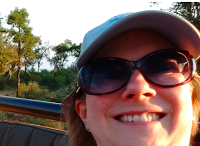 In his recent blog post about how many illustrators like to sketch when they're out and about and on holiday, Garry Parsons asked: "Now I’m left wondering if authors do this too? Do they sit on the beach on holiday in Minehead conjuring poetry, psalms or haiku just for pleasure? I’m curious!"
In his recent blog post about how many illustrators like to sketch when they're out and about and on holiday, Garry Parsons asked: "Now I’m left wondering if authors do this too? Do they sit on the beach on holiday in Minehead conjuring poetry, psalms or haiku just for pleasure? I’m curious!"Intrinsic to our craft is the fact that authors, like illustrators, never really take time off - our minds are constantly finding ideas and fine-tuning characters, plots and story arcs. On holiday, we sit on airplanes, trains, diners, cafés and at the in-law's dinner table listening to dialogue, experiencing situations and new scenery that will very likely, one day re-emerge in our books.
A few of the bloggers in the Den have commented that they carry around a notebook and jot down ideas and snippets that will perhaps later become books. Others, said they have a go at drawing too. I do both those things, but find that the notebook musings come second to a whole bunch of other activities (see below).
Being freelance comes with all kinds of challenges to do with when you are actually on a designated holiday and when you're supposed to be working. But I do try to take time off. Because it's important to just 'be' and let new vistas come and refresh the page. I love being close to nature and walking.
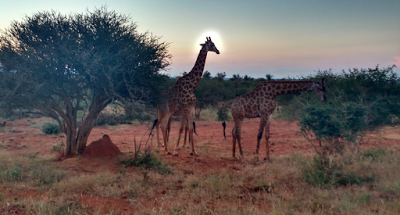 I took this snap on a holida in RSA to celebrate my mum and my birthdaysI am not yet lucky enough to count myself as a full-time writer, and so I find myself actively having to carve out time to write. Having recently embarked on picture book non-fiction– and then actually having sold something in this genre – I discovered that I can suddenly spend my holiday time researching all kinds of seemingly useless information in the name of being a writer. This is actually really quite fun.
I took this snap on a holida in RSA to celebrate my mum and my birthdaysI am not yet lucky enough to count myself as a full-time writer, and so I find myself actively having to carve out time to write. Having recently embarked on picture book non-fiction– and then actually having sold something in this genre – I discovered that I can suddenly spend my holiday time researching all kinds of seemingly useless information in the name of being a writer. This is actually really quite fun.So, this summer, whilst on holiday in Pennsylvania, I:
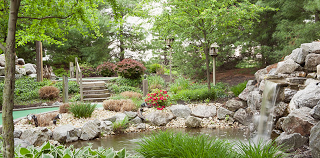 The mini-golf course was filled with unexpected hurdles . . .- played mini-golf with my family in a place called Bird-in-Hand (boy, this shows up personalities that make for good characters!)
The mini-golf course was filled with unexpected hurdles . . .- played mini-golf with my family in a place called Bird-in-Hand (boy, this shows up personalities that make for good characters!)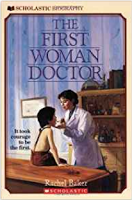 - went to the library and checked out a dog-eared young fiction biography of Elizabeth Blackwell, first woman doctor so I could see if it had any nuggets in it (and because she's a lady Judy Moody admires and I knew nothing about)
- went to the library and checked out a dog-eared young fiction biography of Elizabeth Blackwell, first woman doctor so I could see if it had any nuggets in it (and because she's a lady Judy Moody admires and I knew nothing about)- read the fascinating story of William Kamkwamba, who changed his people's world by inventing and building a simple windmill with scraps, despite the famine and because of the village library (and that his story is now a bestselling sensation because of a blogger)
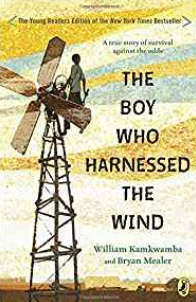
- studied a whole bunch of non-fiction picture books and studied how other people who get paid to do this stuff do it well

- watched a few episodes of Frasier on TV (to research humour of course)
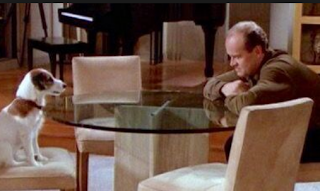 Staring contest from 'Frasier' -Eddie wins- spent several hours in the hammock reading Judy Moody, Hank Zipzer and several other American young fiction series (again, for research of course)
Staring contest from 'Frasier' -Eddie wins- spent several hours in the hammock reading Judy Moody, Hank Zipzer and several other American young fiction series (again, for research of course)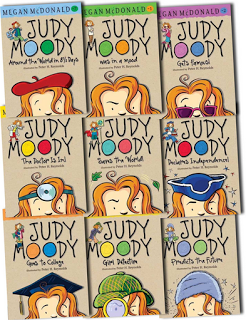
- visited the Crayola factory to see how they make crayons in real life (I know, how cool is that!)

- spent copious hours the floor of the children's section of Barnes & Noble and any other bookshop my family would let me near . . .

I also:
- hiked in beautiful Valley Forge National Park with the dogs (and worked out plot problems and suchlike)
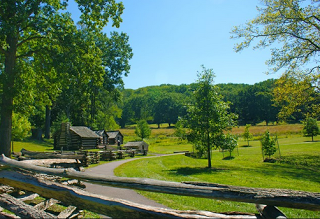
- bought a vivid set of Crayola pastels and swirled some backgrounds for my new author website
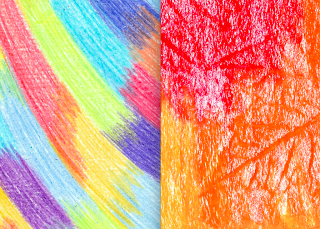
- was lucky enough to be invited by my lovely new agent to a weekend retreat in Vermont to hang out with fellow clients. Sitting by the peaceful riverside, we each shared a work in progress with the eight other retreaters. Though I found this daunting because I'd never met any of them before, it was a very useful experience and the feedback invaluable. We ate, laughed and hiked, plus discovered that Victoria Wells Arms is a master chef.
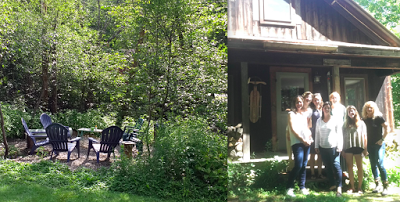
- oh and sometimes, I wrote. Yes, when I'm on holiday, I can do that.
What did you do on your summer holiday?
________________________
Natascha Biebow
Author, Editor and Mentor
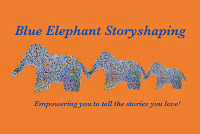 Blue Elephant Storyshaping is an editing, coaching and mentoring service aimed at empowering writers and illustrators to fine-tune their work pre-submission. Check out my small-group coaching Cook Up a Picture Book courses! Natascha is also the author of The Crayon Man (coming in 2019), Elephants Never Forget and Is This My Nose?, editor of numerous award-winning children’s books, and Co-Regional Advisor (Co-Chair) of SCBWI British Isles.
Blue Elephant Storyshaping is an editing, coaching and mentoring service aimed at empowering writers and illustrators to fine-tune their work pre-submission. Check out my small-group coaching Cook Up a Picture Book courses! Natascha is also the author of The Crayon Man (coming in 2019), Elephants Never Forget and Is This My Nose?, editor of numerous award-winning children’s books, and Co-Regional Advisor (Co-Chair) of SCBWI British Isles.
Published on September 24, 2017 19:30
September 17, 2017
Picture Books and Animation • An Vrombaut
This week we have a guest blog from multi-talented author-illustrator-animator An Vrombaut exploring the differences between working in picture books and animation.
I trained as an animator and now work as a creator and writer of animated programmes for pre-school television. I have also written and illustrated fifteen picture books. One of my picture books has been adapted for animation (Dear Dragon / Florrie’s Dragons) and one of my animated stories have been adapted as picture books ( 64 Zoo Lane ). All this means I’ve done a fair bit of hopping back and forth between the worlds of publishing and animation, and I’m often asked what the differences are between working in these different fields.
64 Zoo Lane - The Story of the Whale Trip
The thing about animation is … it’s expensive to produce and it takes time – considerably more time than the making of a picture book! It is not unusual for the development and finance of an animated project to go on for three, five or even seven years… Initially, a production company will option a book for a fee (usually a modest one) which gives the company the right to develop the project during an agreed time period - perhaps one to two years. A pilot episode may be made as a tool to develop and refine the look and content of the animation. It’s also used to show at test screenings to get audience feedback, to establish a production pipeline for the animation, and of course to help raise finance. When the project has been green-lit, the creator should receive a larger rights fee. From this moment, it can take another one to two years to complete the programme depending on the length and on the animation technique used.
[image error]
 64 Zoo Lane – early development drawing
64 Zoo Lane – early development drawing
The level of involvement of the picture book author or illustrator in the making of an animated adaptation can vary greatly, from simple approvals at key stages to consultancy work on design and/or content, to co-writing and co-producing. Contracts tend to be more complex than publishing contracts, so it’s advisable to work with an agent. Alternatively you could get a media lawyer to look at contracts, but this can work out costly!
Another key difference between publishing and animation is that writing and illustrating picture books tends to be a solitary profession whereas animation is team work. This can take a little time getting used to - yes, it’s likely you will be asked to make changes! However, most picture book authors/illustrators find working with other creatives stimulating.
[image error]
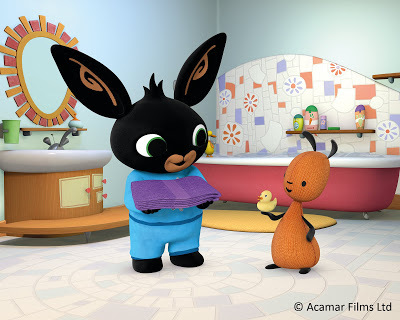 Bing
Bing
It’s exciting for any author/illustrator to receive news of a picture book being adapted for animation, and exhilarating to see characters come to life on a screen. However, the process is not without its pitfalls. There are the legal complexities, the agonising waits during the development and financing phase, the politics and the conflicting demands of having to work with so many different parties… ‘We need you to add a vehicle to this show’ is a phrase often heard from those selling toy merchandising rights. But perhaps the hardest thing from the creator’s point of view is the emotional intensity of seeing your ‘baby’ reborn in a new medium. I have met creators of animated TV programmes who felt utterly drained after the last episode was delivered to the broadcaster. It’s important to keep perspective – and there’s always a little letting go to be done, even on projects where the creator has been closely involved during all stages of the production.
[image error]One thing that has changed for the better over the last decade is a decrease in snobbery on both sides: publishing and animation. Early on in my career I met a literary agent who was happy to represent me as an author but not as an illustrator because she considered my character’s eyes to be ‘too cartoony’. She said picture book characters ought to have simple dot eyes! I’ve also met independent book sellers reluctant to stock a picture book simply because it existed as an animated programme first. I’ve come across snobbery in the world of animation too: animators who look down on TV adaptations of books because - unlike the ‘full animation’ of feature films which requires between 12 and 24 drawings per second - TV animation is more ‘limited’. These days the offering of pre-school animation is much more varied and most of it is of high quality. As a result, working in TV animation is now held in much higher regard by animators. To get an idea of what’s being produced, take a look at Sarah & Duck , Hey Duggee or Lily’s Driftwood Bay - all original creations for TV which use 2D animation to great effect. For a very different look, check out Bing (based on the books by Ted Dewan) which uses photo-realistic 3D CGI animation. And Miffy (based on the work of Dick Bruna) - also made using 3D CGI, but in a minimalist pop-art style true to its book origins.
Miffy’s Adventures Big and Small
Thankfully those small snobberies I came across in the past have all but disappeared. There is much more cross-fertilisation between publishing and animation these days, with people such as Benji Davies, Steven Lenton and Leigh Hodgkinson (creator of the new CBeebies series Olobob Top) working in both media. With the advent of apps, the boundaries between publishing, TV animation and gaming are bound to blur even further.
For anyone interested in animation I would recommend attending the Childrens Media Conference. Held in Sheffield every year during the first week of July, it’s a great opportunity to hook up with producers, directors, script writers, broadcasters etc. Maybe see you there?
You can find out more about An’s books and films at her website and follow her on Facebook and Twitter @anvrombaut.
SaveSave
I trained as an animator and now work as a creator and writer of animated programmes for pre-school television. I have also written and illustrated fifteen picture books. One of my picture books has been adapted for animation (Dear Dragon / Florrie’s Dragons) and one of my animated stories have been adapted as picture books ( 64 Zoo Lane ). All this means I’ve done a fair bit of hopping back and forth between the worlds of publishing and animation, and I’m often asked what the differences are between working in these different fields.
64 Zoo Lane - The Story of the Whale Trip
The thing about animation is … it’s expensive to produce and it takes time – considerably more time than the making of a picture book! It is not unusual for the development and finance of an animated project to go on for three, five or even seven years… Initially, a production company will option a book for a fee (usually a modest one) which gives the company the right to develop the project during an agreed time period - perhaps one to two years. A pilot episode may be made as a tool to develop and refine the look and content of the animation. It’s also used to show at test screenings to get audience feedback, to establish a production pipeline for the animation, and of course to help raise finance. When the project has been green-lit, the creator should receive a larger rights fee. From this moment, it can take another one to two years to complete the programme depending on the length and on the animation technique used.
[image error]
 64 Zoo Lane – early development drawing
64 Zoo Lane – early development drawingThe level of involvement of the picture book author or illustrator in the making of an animated adaptation can vary greatly, from simple approvals at key stages to consultancy work on design and/or content, to co-writing and co-producing. Contracts tend to be more complex than publishing contracts, so it’s advisable to work with an agent. Alternatively you could get a media lawyer to look at contracts, but this can work out costly!
Another key difference between publishing and animation is that writing and illustrating picture books tends to be a solitary profession whereas animation is team work. This can take a little time getting used to - yes, it’s likely you will be asked to make changes! However, most picture book authors/illustrators find working with other creatives stimulating.
[image error]
 Bing
BingIt’s exciting for any author/illustrator to receive news of a picture book being adapted for animation, and exhilarating to see characters come to life on a screen. However, the process is not without its pitfalls. There are the legal complexities, the agonising waits during the development and financing phase, the politics and the conflicting demands of having to work with so many different parties… ‘We need you to add a vehicle to this show’ is a phrase often heard from those selling toy merchandising rights. But perhaps the hardest thing from the creator’s point of view is the emotional intensity of seeing your ‘baby’ reborn in a new medium. I have met creators of animated TV programmes who felt utterly drained after the last episode was delivered to the broadcaster. It’s important to keep perspective – and there’s always a little letting go to be done, even on projects where the creator has been closely involved during all stages of the production.
[image error]One thing that has changed for the better over the last decade is a decrease in snobbery on both sides: publishing and animation. Early on in my career I met a literary agent who was happy to represent me as an author but not as an illustrator because she considered my character’s eyes to be ‘too cartoony’. She said picture book characters ought to have simple dot eyes! I’ve also met independent book sellers reluctant to stock a picture book simply because it existed as an animated programme first. I’ve come across snobbery in the world of animation too: animators who look down on TV adaptations of books because - unlike the ‘full animation’ of feature films which requires between 12 and 24 drawings per second - TV animation is more ‘limited’. These days the offering of pre-school animation is much more varied and most of it is of high quality. As a result, working in TV animation is now held in much higher regard by animators. To get an idea of what’s being produced, take a look at Sarah & Duck , Hey Duggee or Lily’s Driftwood Bay - all original creations for TV which use 2D animation to great effect. For a very different look, check out Bing (based on the books by Ted Dewan) which uses photo-realistic 3D CGI animation. And Miffy (based on the work of Dick Bruna) - also made using 3D CGI, but in a minimalist pop-art style true to its book origins.
Miffy’s Adventures Big and Small
Thankfully those small snobberies I came across in the past have all but disappeared. There is much more cross-fertilisation between publishing and animation these days, with people such as Benji Davies, Steven Lenton and Leigh Hodgkinson (creator of the new CBeebies series Olobob Top) working in both media. With the advent of apps, the boundaries between publishing, TV animation and gaming are bound to blur even further.
For anyone interested in animation I would recommend attending the Childrens Media Conference. Held in Sheffield every year during the first week of July, it’s a great opportunity to hook up with producers, directors, script writers, broadcasters etc. Maybe see you there?
You can find out more about An’s books and films at her website and follow her on Facebook and Twitter @anvrombaut.
SaveSave
Published on September 17, 2017 22:00
September 10, 2017
FROM PAGE TO STAGE: Adapting Picture Books into Children's Theatre • Jonathan Emmett
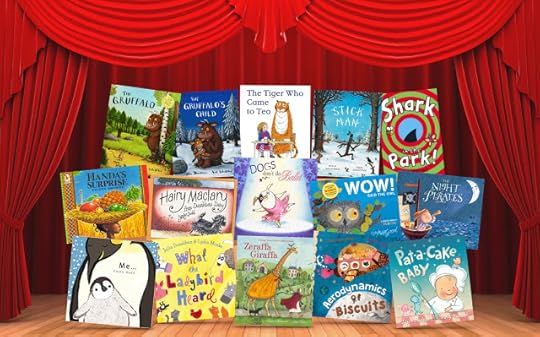 Some of the picture books currently treading the boards in the UK.
Some of the picture books currently treading the boards in the UK.(Scroll down to the bottom of the page for links to each production)
If you're a regular children's theatregoer, you'll be be aware that a growing number of stage shows are adapted from picture books. I'm fortunate to have had several of my picture books adapted for the stage, most recently The Princess and the Pig , which finished a summer tour last week.
While some authors are content to sell the stage rights to their books and let the theatre company take it from there, others like to have some degree of involvement in the adaptation. I'm one of the latter group; I always ask for script approval before an adaptation goes ahead. I usually have a few comments and suggestions on the early drafts and, once the script is approved, I'll continue to give feedback on the adaptation for as long as the theatre company wants me to, which can mean sitting in on rehearsals or reviewing marketing and publicity material.
Although picture books and theatre have many things in common (see Timothy Knapman's excellent PBD post here), they are very different media and what works well on the page, will not necessarily work well on the stage. Successfully translating a story from one to the other takes a great deal of skill across a wide range of disciplines: the list of creative contributors involved in a stage adaptation may include a scriptwriter, director, composer, lyricist, actors, musicians, set designer, costume designer, puppet maker, and lighting designer. However in smaller adaptations, individuals will usually take on two or three of these roles.
Here are five things that I've learnt from working with theatre companies on the stage adaptations of my picture books.
1: DO make a song and dance of it!A common ingredient of most picture book adaptations is music and all of the shows that have been adapted from my picture books have included songs that were written for the adaptation. Songs are sometimes sung to a pre-recorded accompaniment, but it’s not unusual for the music to be played live as part of the performance.
In Belfield and Slater’s adaptation of Here Be Monsters all of Simon Slater’s score is performed live by a cast of actor-musicians. The original picture book is written in rhyme and Simon incorporated some of the couplets from the original text into his lyrics.
 Poly Bernatene's illustration and Ben Tolley as Captain Cut-Throat, Eloise Secker as Sneaky McSqueaky, Lauren Storer as Quilly von Squint, Toby Vaughan as Stinky O'Bleary and Josh Sneesby as Findus Spew performing one of the songs from Belfield and Slater's adaptation of Here be Monsters. Photo: Ian Holder.
Poly Bernatene's illustration and Ben Tolley as Captain Cut-Throat, Eloise Secker as Sneaky McSqueaky, Lauren Storer as Quilly von Squint, Toby Vaughan as Stinky O'Bleary and Josh Sneesby as Findus Spew performing one of the songs from Belfield and Slater's adaptation of Here be Monsters. Photo: Ian Holder.2: "Make 'em laugh!"Children love to laugh and another common ingredient of many, if not most, picture book adaptations is comedy. In many adaptations the comedy stems from the original picture book, but it's often added in to a stage adaptation to provide moments of light relief in more serious stories.
The first of my picture books to be adapted for the stage was Bringing Down the Moon , illustrated by Vanessa Cabban. While the picture book has some gentle humour, I would not describe it as a comedy. Whereas Peaceful Lion's stage show was frequently laugh-out-loud funny – and all the more enjoyable for it!
 Vanessa Cabban's illustration and Henry Wyrley-Birch as Mole and Victoria Andrews as Rabbit in Peaceful Lion's stage adaptation of Bringing Down the Moon. Photo: Pamela Raith.
Vanessa Cabban's illustration and Henry Wyrley-Birch as Mole and Victoria Andrews as Rabbit in Peaceful Lion's stage adaptation of Bringing Down the Moon. Photo: Pamela Raith.3: "It's good to talk!"Word count restrictions tend to limit the amount of dialogue that authors and illustrators can include in a picture book. The same restrictions do not apply to stage adaptations and scriptwriters will usually take advantage of this, adding extra dialogue to flesh out characters and embellish the plot.
The Santa Trap 's beastly anti-hero Bradley Bartleby spends most of the original picture book alone in his booby-trapped mansion. Consequently the book has little dialogue and most the story is told in narration (along with Poly Bernatene's wonderfully atmospheric illustrations). Unfortunately a children's show in which so little is said by the characters is unlikely to hold the interest of a young audience. Belfield and Slater's stage adaptation solved this problem by expanding the roles of the three secretaries who only appear on one page of the picture book. In the stage version, the three secretaries become Bradley's reluctant stooges, giving him someone to talk to (or in Bradley's case - shout at) and interact with throughout the play.
 Poly Bernatene's illustration and Toby Vaughan as Bradley, with Eloise Secker, Lauren Storer and Josh Sneesby as secretaries Scribe, Scribble and Smythe in Belfield and Slater's adaptation of The Santa Trap.
Poly Bernatene's illustration and Toby Vaughan as Bradley, with Eloise Secker, Lauren Storer and Josh Sneesby as secretaries Scribe, Scribble and Smythe in Belfield and Slater's adaptation of The Santa Trap.4: Sometimes story elements have to be added in …Entirely original story elements such as new characters, settings, scenes and subplots are sometimes needed for a stage adaptation.
The original picture book cast of Ruby Flew Too! were joined by two new birdwatcher characters who acted as narrators in Topsy Turvy Theatre's stage adaptation of the book.
 Rebecca Harry's illustration and Claire Alizon Hills and Rachel Priest as the birdwatchers with Jessica Kay's puppets in Topsy Turvy Theatre's adaptation of Ruby Flew Too!
Rebecca Harry's illustration and Claire Alizon Hills and Rachel Priest as the birdwatchers with Jessica Kay's puppets in Topsy Turvy Theatre's adaptation of Ruby Flew Too! 5: … and sometimes story elements have to be taken out.The writer's maxim "kill your darlings" applies to adaptations as much as original stories and sometimes much-loved elements of the original picture book need to be removed completely for the story to enable it to work well on stage.
A popular element of the original picture book version of The Princess and The Pig is the way characters hold up books they've read to back up their (usually misguided) theories about what is happening in the story. The refrain "It's the sort of thing that happens all the while in books," is repeated throughout the text, culminating in the final punchline, "Unfortunately for the prince, it's not what happen's in this particular book". The first draft I was shown of Folksy Theatre's script for their stage adaptation of the book retained this refrain and punchline, but it didn't feel quite right for the stage show. Much of the show's audience would be unaware that the story they were watching was adapted from a book, so I felt it would make more sense if the final punchline was altered to, "it's not what happens in this particular story." And once "story" was used in the punchline it it had to be swapped in throughout the rest of the play as well. Folky's scriptwriter and director Lee Hardwicke agreed and cut the "book" references from her script.
 One of Poly Bernatene's illustrations and Emma Kemp as the Queen, Christopher Pegler-Lambert as the King and Em Watkins operating Sarah Lewis's pig puppet in Folksy Theatre's adaptation of The Princess and the Pig.
One of Poly Bernatene's illustrations and Emma Kemp as the Queen, Christopher Pegler-Lambert as the King and Em Watkins operating Sarah Lewis's pig puppet in Folksy Theatre's adaptation of The Princess and the Pig.I hope this post has whetted your appetite for some picture book performances. Here's a selection of stage shows adapted from picture books that are currently showing in the UK. If you know of any more, feel free to link to them in the comments box below.
UK Stage Adaptations of Picture Books Showing in September 2018
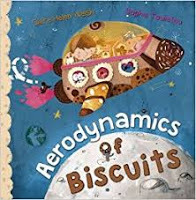 AERODYNAMICS OF BISCUITS
AERODYNAMICS OF BISCUITSby Clare Helen Welsh and Sophia Touliatou
adapted by Entertainingly Different
http://entertaininglydifferent.com/projects
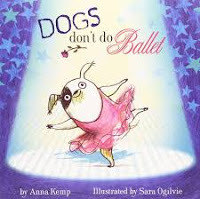 DOGS DON’T DO BALLET
DOGS DON’T DO BALLETby Anna Kemp and Sarah Oglivie
adapted by Little Blue Monster Productions
http://www.littlebluemonster.co.uk/book-tickets/4593853200
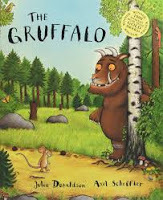 THE GRUFFALO
THE GRUFFALOby Julia Donaldson and Axel Scheffler
adapted by Tall Stories
http://www.tallstories.org.uk/the-gruffalo
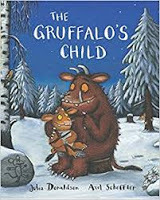 THE GRUFFALO'S CHILD
THE GRUFFALO'S CHILDby Julia Donaldson and Axel Scheffler
adapted by Tall Stories
http://www.tallstories.org.uk/the-gruffalos-child
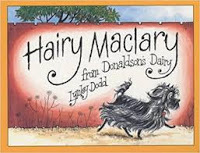 HAIRY MACLARY AND FRIENDS
HAIRY MACLARY AND FRIENDSby Lynley Dodd
adapted by Nonsense Room
http://nonsenseroom.co.uk/wp/hairy-maclary-friends/
 HANDA’S SURPRISE
HANDA’S SURPRISEby Eileen Browne
adapted by Little Angel Theatre
https://littleangeltheatre.com/touring/upcoming-tours/
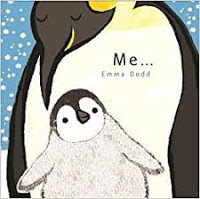 ME
MEby Emma Dodd
adapted by Little Angel Theatre
https://littleangeltheatre.com/touring/upcoming-tours/
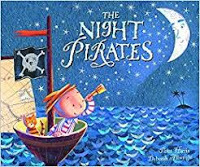 THE NIGHT PIRATES
THE NIGHT PIRATESby Peter Harris and Deborah Allwright
adapted by Nick Brooke
http://www.nickbrooke.com/childrens-theatre/the-night-pirates/performance-info
 PAT-A-CAKE BABY
PAT-A-CAKE BABYby Joyce Dunbar and Polly Dunbar
adapted by Long Nose Puppets
http://www.longnosepuppets.com/tour-dates.html
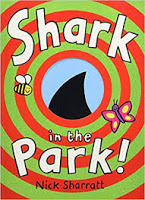 SHARK IN THE PARK
SHARK IN THE PARKby Nick Sharrat
adapted by Nonsense Room
http://nonsenseroom.co.uk/wp/
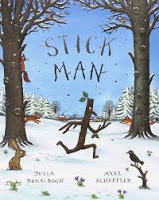 STICK MAN
STICK MANby Julia Donaldson and Axel Scheffler
adapted by Scamp Theatre
http://www.stickmanlive.com
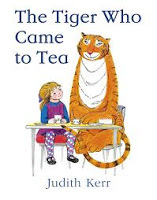 THE TIGER THAT CAME TO TEA
THE TIGER THAT CAME TO TEAby Judith Kerr
adapted by David Wood
http://www.tigerstealive.com/tour/
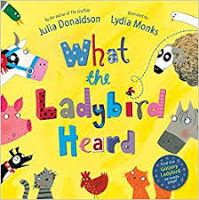 WHAT THE LADYBIRD HEARD
WHAT THE LADYBIRD HEARDby Julia Donaldson and Lydia Monks
adapted by Kenny Wax
http://www.whattheladybirdheardlive.co.uk
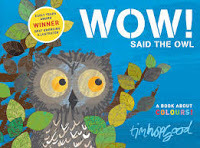 WOW SAID THE OWL
WOW SAID THE OWLby Tim Hopgood
adapted by Little Angel Theatre
https://littleangeltheatre.com/whats-on/september-whats-on/wow-said-the-owl/
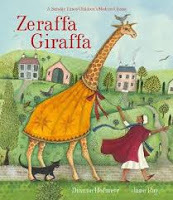 ZERAFFA GIRAFFA
ZERAFFA GIRAFFAby Dianne Hofmeyr and Jane Ray
adapted by Little Angel Theatre
https://littleangeltheatre.com/whats-on/september-whats-on/zeraffa-giraffa/
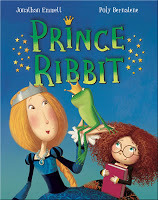 Jonathan Emmett's latest picture book (which would make a wonderful stage show!) is Prince Ribbit, illustrated by Poly Bernatene and published by Macmillan Children's Books.
Jonathan Emmett's latest picture book (which would make a wonderful stage show!) is Prince Ribbit, illustrated by Poly Bernatene and published by Macmillan Children's Books. Find out more about Jonathan and his books at his Scribble Street web site or his blog. You can also follow Jonathan on Facebook and Twitter @scribblestreet.
See all of Jonathan's posts for Picture Book Den.
Published on September 10, 2017 22:00
September 3, 2017
Picture Books That Talk about Floods - Chitra Soundar
The recent hurricane in Texas and the floods in the Indian subcontinent, has made me thinking about how we talk about natural disasters to children.
My own picture book Pattan’s Pumpkin is a flood story too – and it talks about how Pattan had to make a boat from a giant pumpkin to escape the floods in the valley in they lived.
So I went to look about other picture books handle the traumatic concepts of floods and its effects for children.
Here are the ones I found – perhaps of use to you in your classrooms to discuss the topic that must be on children’s minds.
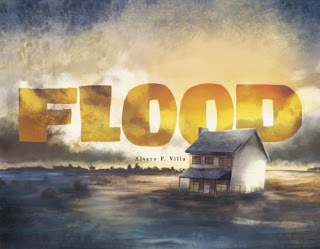 Floodby Alvaro F. Villa
Floodby Alvaro F. Villa
This is a wordless picture book – it shows the preparation of a family of an impending storm and how they evacuate and their house gets flooded. It also shows how the family pull together on their return to restore their house to order and life resumes. It is a wonderful way to bring out conversations in classrooms – be it in younger ages or older.
Floodby Gillian McClure
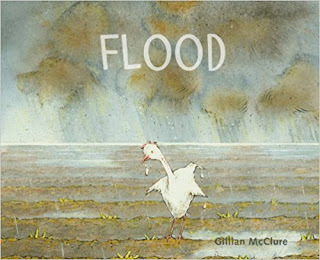
In this book the victims are three friend – an ox, a fox and a hen. They are caught up in a flood and they need to work together to reach land.
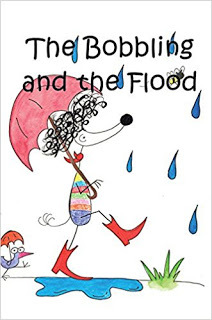 In contrast, The Bobbling and the Flood is a comic take on what do with a flood. Bobbling Poodle Doodle wants to clear the floor by finding the plughole. The result is hilarious though.
In contrast, The Bobbling and the Flood is a comic take on what do with a flood. Bobbling Poodle Doodle wants to clear the floor by finding the plughole. The result is hilarious though.
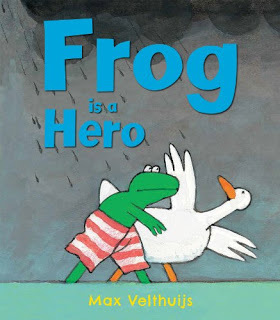 And finally Frog is a Hero is a digital edition from Andersen in which we find out about how Frog saves his friends when the river bursts its banks.
And finally Frog is a Hero is a digital edition from Andersen in which we find out about how Frog saves his friends when the river bursts its banks.
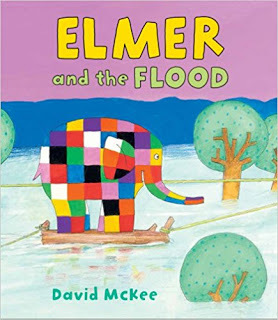 And finally one of my favourites – Elmer and the Flood in which Elma has to rescue a young stranded elephant when the forest is flooded due to heavy rains.
And finally one of my favourites – Elmer and the Flood in which Elma has to rescue a young stranded elephant when the forest is flooded due to heavy rains.
These five titles will trigger conversations about what happens during a flood, how do we prepare for them and how to deal with the aftermaths. Children will be able to relate to, empathise and talk about families across the world caught up in such disasters.
Do you know of other books you can recommend?
Find out more about Chitra Soundar at www.chitrasoundar.com or Follow her on Twitter @csoundar
My own picture book Pattan’s Pumpkin is a flood story too – and it talks about how Pattan had to make a boat from a giant pumpkin to escape the floods in the valley in they lived.
So I went to look about other picture books handle the traumatic concepts of floods and its effects for children.
Here are the ones I found – perhaps of use to you in your classrooms to discuss the topic that must be on children’s minds.
 Floodby Alvaro F. Villa
Floodby Alvaro F. Villa This is a wordless picture book – it shows the preparation of a family of an impending storm and how they evacuate and their house gets flooded. It also shows how the family pull together on their return to restore their house to order and life resumes. It is a wonderful way to bring out conversations in classrooms – be it in younger ages or older.
Floodby Gillian McClure

In this book the victims are three friend – an ox, a fox and a hen. They are caught up in a flood and they need to work together to reach land.
 In contrast, The Bobbling and the Flood is a comic take on what do with a flood. Bobbling Poodle Doodle wants to clear the floor by finding the plughole. The result is hilarious though.
In contrast, The Bobbling and the Flood is a comic take on what do with a flood. Bobbling Poodle Doodle wants to clear the floor by finding the plughole. The result is hilarious though. And finally Frog is a Hero is a digital edition from Andersen in which we find out about how Frog saves his friends when the river bursts its banks.
And finally Frog is a Hero is a digital edition from Andersen in which we find out about how Frog saves his friends when the river bursts its banks. And finally one of my favourites – Elmer and the Flood in which Elma has to rescue a young stranded elephant when the forest is flooded due to heavy rains.
And finally one of my favourites – Elmer and the Flood in which Elma has to rescue a young stranded elephant when the forest is flooded due to heavy rains.These five titles will trigger conversations about what happens during a flood, how do we prepare for them and how to deal with the aftermaths. Children will be able to relate to, empathise and talk about families across the world caught up in such disasters.
Do you know of other books you can recommend?
Find out more about Chitra Soundar at www.chitrasoundar.com or Follow her on Twitter @csoundar
Published on September 03, 2017 23:00
August 27, 2017
The Illustrator's Busman's Holiday : Garry Parsons
Among the things I enjoy seeing posted on Twitter are illustrator’s roughs for the projects they are working on. I’ve always been curious to know how other illustrators develop their work because everyone’s process of working is unique. These initial character sketches and pencil outlines sometimes give you a hint of that process and would have mostly gone unseen in the days before social media.
Recently my attention has been drawn to posts that have included observational drawings, city scenes or landscapes and even life drawing, all of which appear separate from work projects and made out of studio time. These drawings are often accompanied by a text or a title alluding to the illustrator being on holiday, travelling or simply having a few minutes to spare in a coffee shop or killing time on a station platform. Some of these drawings are superb!
 Hannah Warren - Montenegro Sketch book and "Black Lake"
Hannah Warren - Montenegro Sketch book and "Black Lake"I have always drawn (well ever since I can remember anyway) and when I visit schools today I often tell the children that I have been practicing my pencil skills since I was first born. (I draw a baby version of myself to illustrate this). So when I studied painting at art college it wasn’t a challenge for me when the tutors encouraged the students to carry a sketchbook with them at all times because I already did and still do today. So, when I’m travelling or going on holiday, my bags always include drawing equipment and sketchbooks, which appear before swimming trunks and passports on my packing list.
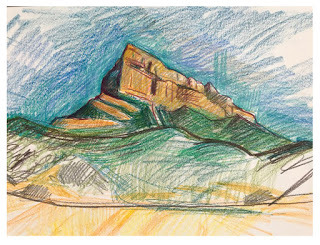 Garry Parsons - El Turbón, Spain
Garry Parsons - El Turbón, SpainOn a recent trip to Somerset with my seven-year-old son, we stopped on a hillside, got a blanket out of the car and sketched the landscape together. My son confidently explained to me that there was “no imagination needed” because it’s all there, right in front of you – the hills, the farm, the trees and cattle – and “you don’t have to make it up!”
 Garry Parsons - Kilve Beach, Somerset. Guy Parker-Rees - Sussex Downs
Garry Parsons - Kilve Beach, Somerset. Guy Parker-Rees - Sussex DownsHe was right, of course, in some ways. Drawing on a hillside, there are no deadlines, art directors, editors, sales team or authors to consider. No one was going to suggest I use a different colour or change the eyes on the cows from circles to dots. What there is, though, is a quiet joy in just sitting and drawing what you see, especially on a warm evening in a beautiful place with another artist, even if they are just seven. But, despite having carried a sketchbook with me most of my life and always feeling the urge to sit and draw, this was the first time I’d really considered what it was that actually compels me to do it. And it’s a curious question to ponder. I can come up with many different answers, most of them valid in some way or other, but what it really comes down to is feeling a sense of ease through drawing what you see. It’s like a necessary nourishment that’s unique and personal.
 Garry Parsons - Santa Cruz de la Serós and Luz-Saint-Sauveur.
Garry Parsons - Santa Cruz de la Serós and Luz-Saint-Sauveur.So after my son’s encouraged revelation I made a mental note each time I spotted a landscape or holiday sketch posted by an illustrator on Twitter to ask them the same question, what is it that motivates them to continue drawing “out of studio hours” when probably, like me, they spend most of their day drawing anyway. Guy Parker-Rees told me: “I love drawing and painting landscapes when I have the time and I go life drawing every week. Life drawing is the very best way of keeping that loose connection between eye and hand. I love the freedom to let go and experiment when doing my own work. No brief, no deadline, just enjoying the process. I'm sure it always feeds back into my illustration work: it's a way of trying things out, maybe using different media or techniques.I think it's important to keep experimenting with different ways of working in order to keep your style fresh and to make sure it keeps growing and evolving.”
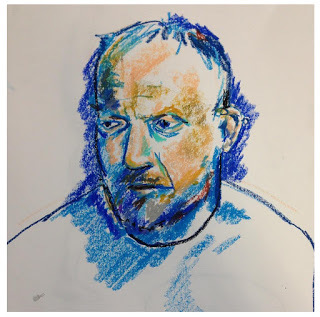 Guy Parker-Rees - 20 minute life drawing
Guy Parker-Rees - 20 minute life drawingAnd the dexterous Hannah Warren told me:“I draw to relax and to think and to observe and to remember. Drawing for yourself is very different and private and many things just stay in the number of small sketchbooks. It's good to have something that’s just for you. Some things though, are used as a basis for commissioned work, like an interesting person walking their dog, someone smoking on a wall, a couple having an argument. I like to look a lot at body language and how people just go about their lives. My work has so many people in it because that’s what I’m most interested in. As for drawing “on holiday” this is again to record a new place.”
 Hannah Warren - Sketch
Hannah Warren - SketchI’ve seen some beautiful work worthy of high praise from many other illustrators too, Adam Stower and Thomas Docherty to name a couple. Wonderful artists with acutely refined drawing skills, the depth of which just might have been concealed within the confines of picture book characters or a commercially designed illustration job but glimpsed in these “out of studio” works. So if you enjoy a good drawing, these are well worth looking out for on your Twitter feed!
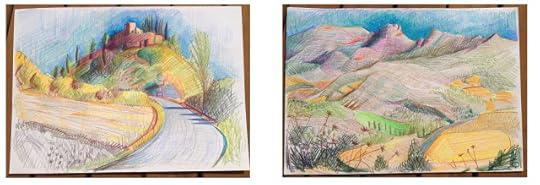 Garry Parsons - Roda de IsábenaBut now I’m left wondering if authors do this too? Do they sit on the beach on holiday in Minehead conjuring poetry, psalms or haiku just for pleasure? I’m curious!
Garry Parsons - Roda de IsábenaBut now I’m left wondering if authors do this too? Do they sit on the beach on holiday in Minehead conjuring poetry, psalms or haiku just for pleasure? I’m curious!***
Guy Parker-Rees is the award-winning illustrator of Giraffes Can't Dance which has sold over 215,000 copies. He is extensively published by Orchard, Walker and Little Tiger. Visit Guy's website HERE and follow him on twitter @Guyguyyug
Hannah Warren is an illustrator and bike lady who lives and works in South London and has recently worked for The New York Times and The Sunday Telegraph as well as in publishing. Hannah's work has also been animated for broadcast. Visit Hannah's website HERE and follow her on Twitter @_hannah_warren_
Garry Parsons is an award winning illustrator of children's books including the best selling picture book "The Dinosaur That Pooped Christmas" by Tom Fletcher and Dougie Poynter. Visit Garry's website HERE and follow him on Twitter @ICanDrawDinos
Published on August 27, 2017 16:39
August 20, 2017
What Author Has Inspired You Most? by Jane Clarke
For me, it’s got to be Gerald Durrell. As a child, I read all of his books I could get my hands on at the local library, then gradually built up my own collection:
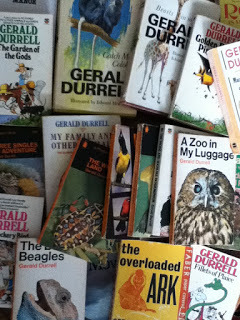
This summer, I’ve treated myself to a Durrell-fest, re-reading them in the order they were written, starting off with The Overloaded Ark which was first published in 1953 (the year before I was born). The books are products of their times, so some aspects are shudder-makingly politically incorrect, but overall it struck me that the qualities that I enjoyed and still enjoy in Gerald Durrell’s writing are ones I enjoy in all books, and subconsciously aim for when I’m writing picture book texts:The tone is nice and friendly. However eccentric and/or different people - and animals - are accepted for who they are and portrayed sympathetically and with humour - even if they are members of your family.
My Family and Other Animals 1956They create clear pictures in your mind (even where there are no illustrations). Each person and animal has a distinctive voice, and often a really interesting name, like Eggbert:
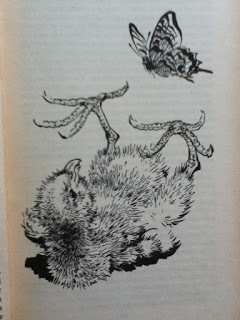 Egbert illustrated by Ralph Thomson from The Drunken Forest, 1956The stories are bursting with adventure, energy and enthusiasm (and so are the titles).
Egbert illustrated by Ralph Thomson from The Drunken Forest, 1956The stories are bursting with adventure, energy and enthusiasm (and so are the titles).
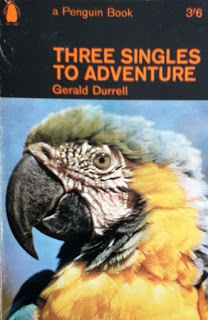 Three Singles to Adventure, 1961
Three Singles to Adventure, 1961
There’s a sense of purpose - the message of conservation is well ahead of its time, and that message is still loud and clear in one of his last books, written with his wife Lee:
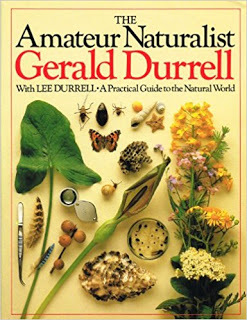 The Amateur Naturalist, 1982
The Amateur Naturalist, 1982
For me, Gerald Durrell's writing inspires awe and wonder for the natural world and a desire to find out more about every creature.
This summer, for the first time, I read Gerald Durrell: The Authorised Biography by Douglas Botting (2000). I discovered that, as well as being a charming and articulate champion of wildlife, the man behind the books was a complex and often difficult character. Writing didn’t come easy to him.

As a child, I often wished I could meet Gerald Durrell. According to the Authorised Biography, he started writing My Family and Other Animals in 1955 when he and his wife were living in an apartment at 70A Holden Road, Woodside Park, London. In 1975, my late husband and I started our life together in an apartment at 72A Holden Road. So we were next door neighbours 20 years apart - an incredibly tenuous connection, but one that put a big smile on my face!
What author has inspired you most?
Jane's picture books all feature animals in some way, shape or form, and she has lots of fun researching each and every one, even though very little of the research gets used in the texts!Jane's website

This summer, I’ve treated myself to a Durrell-fest, re-reading them in the order they were written, starting off with The Overloaded Ark which was first published in 1953 (the year before I was born). The books are products of their times, so some aspects are shudder-makingly politically incorrect, but overall it struck me that the qualities that I enjoyed and still enjoy in Gerald Durrell’s writing are ones I enjoy in all books, and subconsciously aim for when I’m writing picture book texts:The tone is nice and friendly. However eccentric and/or different people - and animals - are accepted for who they are and portrayed sympathetically and with humour - even if they are members of your family.

My Family and Other Animals 1956They create clear pictures in your mind (even where there are no illustrations). Each person and animal has a distinctive voice, and often a really interesting name, like Eggbert:
 Egbert illustrated by Ralph Thomson from The Drunken Forest, 1956The stories are bursting with adventure, energy and enthusiasm (and so are the titles).
Egbert illustrated by Ralph Thomson from The Drunken Forest, 1956The stories are bursting with adventure, energy and enthusiasm (and so are the titles). Three Singles to Adventure, 1961
Three Singles to Adventure, 1961There’s a sense of purpose - the message of conservation is well ahead of its time, and that message is still loud and clear in one of his last books, written with his wife Lee:
 The Amateur Naturalist, 1982
The Amateur Naturalist, 1982For me, Gerald Durrell's writing inspires awe and wonder for the natural world and a desire to find out more about every creature.
This summer, for the first time, I read Gerald Durrell: The Authorised Biography by Douglas Botting (2000). I discovered that, as well as being a charming and articulate champion of wildlife, the man behind the books was a complex and often difficult character. Writing didn’t come easy to him.

As a child, I often wished I could meet Gerald Durrell. According to the Authorised Biography, he started writing My Family and Other Animals in 1955 when he and his wife were living in an apartment at 70A Holden Road, Woodside Park, London. In 1975, my late husband and I started our life together in an apartment at 72A Holden Road. So we were next door neighbours 20 years apart - an incredibly tenuous connection, but one that put a big smile on my face!
What author has inspired you most?
Jane's picture books all feature animals in some way, shape or form, and she has lots of fun researching each and every one, even though very little of the research gets used in the texts!Jane's website
Published on August 20, 2017 22:30
August 6, 2017
Favourite Picture Books of Writers and Illustrators ● Paeony Lewis
“What’s your favourite picture book?” Argh! That’s such a tricky question. Is it a favourite picture book to share with children? Or a favourite picture book you enjoy as an adult?
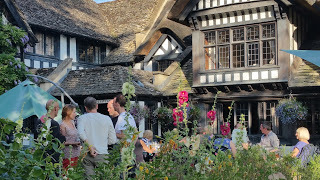 Escaping to the country
Escaping to the country
to immerse ourselves in picture books
Recently, at a long weekend in the depths of the English Cotswolds, a collection of children’s picture book writers and illustrators shared their answers to this questionable question (and they couldn't pick their own books!). It’s a wonderful way to discover new picture books and see familiar ones with fresh eyes. So I thought I’d share their choices, even if I‘m staggered at some of the books chosen (ha ha, I won’t say which!).
The discussions were originally recorded in my scruffy writing in my scruffy notebook. Apologies if I’ve misunderstood anyone and just contact me if you want anything changed. In general, I only included those who are published because although I mentioned I'd be writing a blog post, I didn't ask individuals and those who are published are more familiar with seeing all manner of stuff about themselves on the internet (even nonsense!).
Also look out for extra VIDEO LINKS. Later that weekend Candy Gourlay grabbed some of us to talk about our choices on camera (we were totally unprepared – well I was!).
THE THREE PIGS by David Wiesner (Clarion Books 2001)
Chosen by guest speaker and author/illustrator, Adam Stower + Video
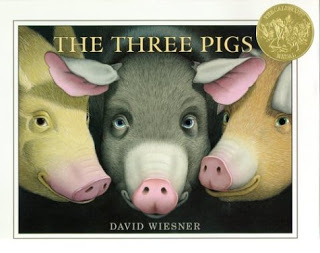 The words and pictures come together to create something greater than the individual parts. It starts off lulling you into a sense of traditional security. Then the pig literally blows the pig right out of the visual frame of the story. There are speech bubbles followed by a wonderful word-free journey with a surprise at every turn.
The words and pictures come together to create something greater than the individual parts. It starts off lulling you into a sense of traditional security. Then the pig literally blows the pig right out of the visual frame of the story. There are speech bubbles followed by a wonderful word-free journey with a surprise at every turn.
GRUMPY FROG by Ed Vere (Puffin 2017 )
Chosen by author/illustrator Mike Brownlow + Video
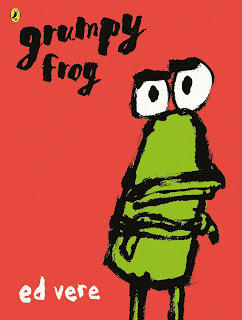
A new book which has been stylistically pared back. The lines are out of the ordinary and all unnecessary detail has been removed and the colours are particularly strong. The book removes or plays with the authorial voice and there’s a dialogue with the reader.
Mike also sneaked in WE FOUND A HAT by Jon Klassen (Walker Books 2016) because the dialogue between the two characters appealed, and the ethical dilemma is told in a refreshing way.
THERE'S A PIG UP MY NOSE by John Dougherty & Laura Hughes (Egmont 2017)
Chosen by author Julie Fulton
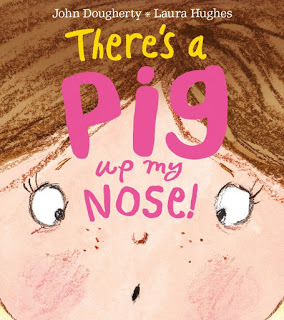
It's great fun though probably a bit of a 'Marmite' book (non-British readers: this means you'll either love it or hate it!). The trotter prints in the illustrations and the very matter-of-fact way the characters accept the doctor's diagnosis of a pig up the girl's nose add to the enjoyment. The oink repetition is fun to repeat by a child.
WATERLOO & TRAFALGAR by Olivier Tallec (Enchanted Lion Books 2012)
Chosen by guest speaker and publishing art director Zoë Tucker + Video
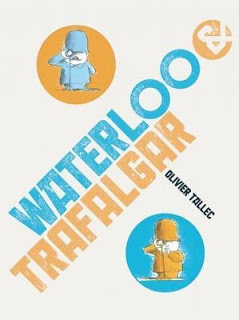
Beautiful and unusual book that is wordless and relies on observational body language. Great characterisation. Adores the cover from a graphic designer's point of view.
CRY, HEART, BUT NEVER BREAK by Glenn Ringtved & Charlotte Pardi (Enchanted Lion Books 2016, originally published in Danish in 2001)
A popular choice and picked by two people, writer Alison and illustrator Rachel Tilda Wolf + Video
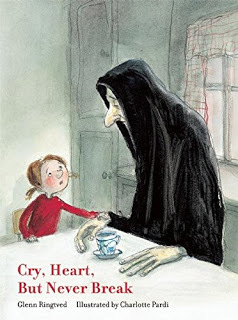
A story within a story. It was the stunning illustrations that first attracted Rachel, and then she fell in love with Death - he has so much respect for everyone. It's such a strong moment when Death puts his hand over the coffee cup and says now is the time.
It was an emotional book for Alison too and she particularly empathised with the intertwining of sorrow and delight; who would enjoy the sun if it never rained?
ONE OF EACH by Mary Ann Hoberman & Marjorie Priceman (Little, Brown and Company, USA 2000)
Chosen by author/illustrator Bridget Marzo + Video (about another favourite: Caleb and Kate by William Steig, 1977)
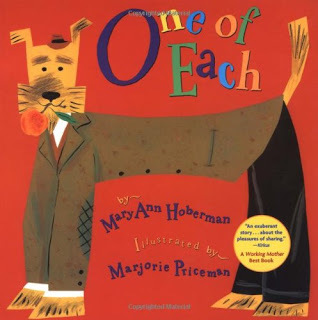
The saturated colour is reminiscent of Matisse. The illustrations work well with the writing and there's a strong rhythm. Bridget enjoyed sharing it with her children who found it hilarious.
PARK IN THE DARK by Martin Waddell & Barbara Firth (new edition Walker Books 2002)
Chosen by illustrator John Shelley
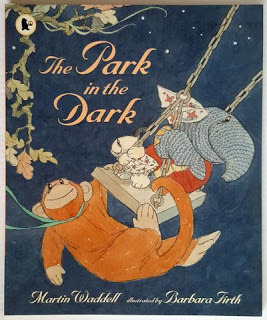
An old favourite. John adores the illustrations but it's the poetic rhythm (not rhyming) of the words that pulls him into the night-time world of the toys. You simply can't stop reading it from beginning to end. A simple story told in a beautiful, poetic way.
HENRI'S WALK TO PARIS by Leonore Klein and illustrated by Saul Bass (originally published in 1962, this edition Universe Publishing, USA, 2012)
Chosen by illustrator Alyana Cazalet + Video
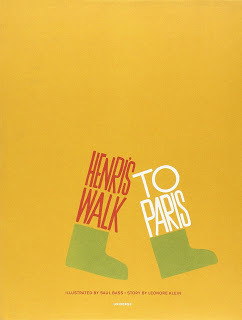
One of many favourites, Alyana loves the work of American, Saul Bass. The illustrations are simple, patterned, and use space, colour and typography in an interesting way. Although the book is about Henri, we never see him, which works well. Plus Bass doesn't use cliched tourist images of Paris. For a book first published in 1962, it looks very contemporary.
WHEN FRANK WAS FOUR by Alison Lester (pb Allen & Unwin, 1997)
Chosen by author Cath Howe + Video
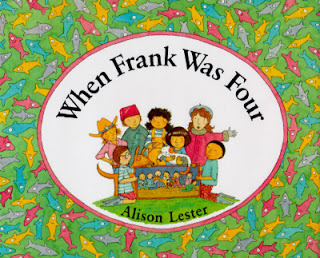
This is a book about real children, to be shared with children. It creates lots of discussion and is not a narrative and breaks expectations of what works in a picture book. Cath likes the way all the children do one thing, whilst one child does something else, and Cath's children love it.
BAHAY KUBO illus by Hermes Alegre (Tahanan Books, 1993)
Chosen by author Candy Gourlay
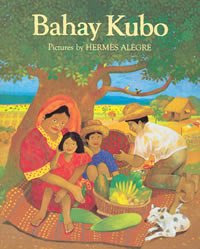
Not in English but we all understood what was happening. This is a traditional folk song that everyone knows in the Philippines. Candy adores the colours and illustrations and picked it because she's especially interested in books that show other countries and cultures that aren't familiar to European children.
Similarly, writer, Cathy, picked THE MOUSEHOLE CAT By Antonia Barber & Nicola Bayley (Walker Books, 1990) partly because it reflects her Cornish identity and life, her language and places. Also, she feels there's a place for longer picture book stories.
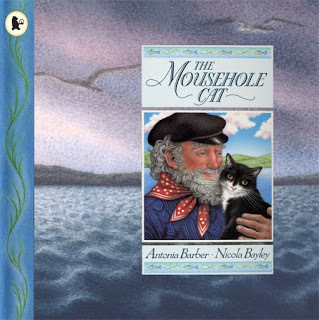
THE RED BOOK by Barbara Lehman (Houghton Mifflin, USA, 2004)
Chosen by author Juliet Clare Bell + Video
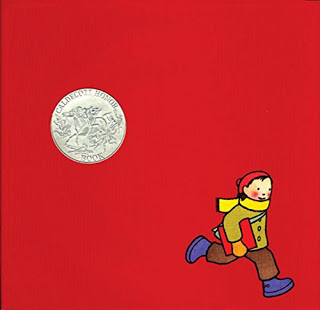
A wordless picturebook, although for Clare the attraction is not in the illustrations. Instead it is about the 'whole thing' and the way the book makes her feel . The wordless story is about two lonely children who meet in an extraordinary way. It's a different form of storytelling.
Another book was chosen for the overall way it made the reader feel. This time it was an unusual (weird?!) book, THE BEAR WHO WANTED TO STAY A BEAR by Jorg Steiner & Jorg Muller (Swedish), originally published in English in 1977. Chosen by illustrator, Paul Morton, and you can find out more in this general video link. Once again, for him it's not the pictures, or even the writing. Instead it's the feeling you get from the book. Despair with a little hope at the end.
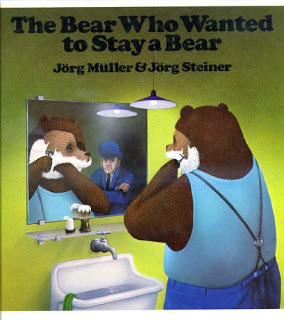
After that book, if you want to cheer yourself up then listen to Gary Fabbi talk about Stickman in the video below.
STICKMAN by Julia Donaldson & Axel Scheffler (Alison Green Books 2008)
Chosen by writer, illustrator and filmaker, Gary Fabbi + Video
Gary loves reading this 'awesome' story to his children and says there are no other books like Stickman. It's a story about homecoming.
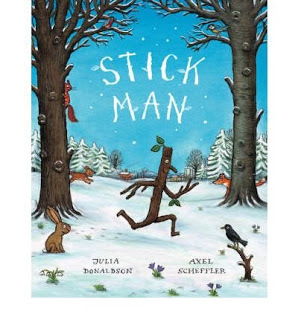
Time to squeeze in my book choices.
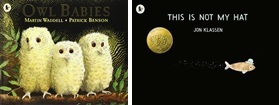 Like others, I brought along several books. There was Owl Babies by Martin Waddell and Patrick Benson - a reassuring tale about separation anxiety and a favourite to read to my young children. Plus This Is Not My Hat by Jon Klassen - I adore the illustration and simplicity of the expressive fish eyes, the deadpan language that says so much, and the childlike morals of the little fish who tries to justify the theft of the hat. However, we had to pick one book and my choice was...
Like others, I brought along several books. There was Owl Babies by Martin Waddell and Patrick Benson - a reassuring tale about separation anxiety and a favourite to read to my young children. Plus This Is Not My Hat by Jon Klassen - I adore the illustration and simplicity of the expressive fish eyes, the deadpan language that says so much, and the childlike morals of the little fish who tries to justify the theft of the hat. However, we had to pick one book and my choice was...
VARMINTS by Helen Ward and Marc Craste (Templar Publishing, 2007, 2013)
Chosen by Paeony Lewis + Video
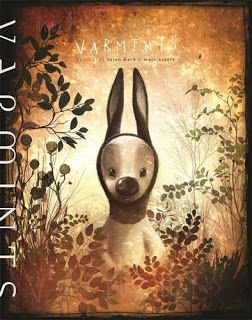
I have two copies: an everyday secondhand copy and a signed hardback in a slipcase. Despite this I hadn't read Varmints in quite a while so if you listen to the video you'll be confused by my chaotic rambling (I panicked and didn't know what to say - which is daft as I can cope with radio interviews!).
Varmints is a slightly abstract tale about being subsumed by urbanisation and cutting ourselves off from nature. But all is not lost and it only takes one person to nurture a seed of hope that spreads change and the return of bees. The illustrations are unusual and atmospheric. Sometimes the text is hard to read, which is deliberate as the noise of industrialisation drowns out sound. Perhaps it's because my degree is in environmental sciences that this is a favourite?
Sadly there's not enough room for all the 'favourites', but here are a few more that other lovely writers and illustrators shared over the weekend.
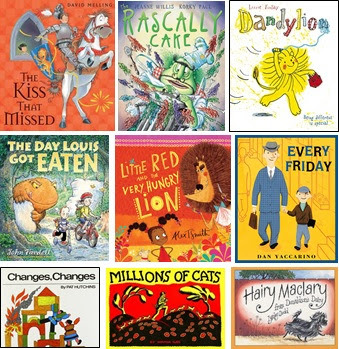
The variety of 'favourites' is staggering. Many were new to me and I found some choices surprising. I think it shows that our personalities and experiences influence our preferences far more than sales hype or academic evaluations of what is 'good'. Plus there's often a difference between our personal favourites (as adults) and the ones we enjoyed sharing with children. For many, 'favourites' are fluid, so often new favourites replace old favourites. I'd love to hear your favourites.
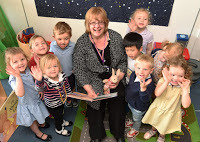 Paeony Lewis
Paeony Lewis
www.paeonylewis.com
PS The long weekend was organised by the SCBWI (Society of Children's Writers and Illustrators), a proactive group that encourages both published and aspiring writers and illustrators. Click picture book weekend for an excellent write-up of the event by Candy Gourlay.
 Escaping to the country
Escaping to the countryto immerse ourselves in picture books
Recently, at a long weekend in the depths of the English Cotswolds, a collection of children’s picture book writers and illustrators shared their answers to this questionable question (and they couldn't pick their own books!). It’s a wonderful way to discover new picture books and see familiar ones with fresh eyes. So I thought I’d share their choices, even if I‘m staggered at some of the books chosen (ha ha, I won’t say which!).
The discussions were originally recorded in my scruffy writing in my scruffy notebook. Apologies if I’ve misunderstood anyone and just contact me if you want anything changed. In general, I only included those who are published because although I mentioned I'd be writing a blog post, I didn't ask individuals and those who are published are more familiar with seeing all manner of stuff about themselves on the internet (even nonsense!).
Also look out for extra VIDEO LINKS. Later that weekend Candy Gourlay grabbed some of us to talk about our choices on camera (we were totally unprepared – well I was!).
THE THREE PIGS by David Wiesner (Clarion Books 2001)
Chosen by guest speaker and author/illustrator, Adam Stower + Video
 The words and pictures come together to create something greater than the individual parts. It starts off lulling you into a sense of traditional security. Then the pig literally blows the pig right out of the visual frame of the story. There are speech bubbles followed by a wonderful word-free journey with a surprise at every turn.
The words and pictures come together to create something greater than the individual parts. It starts off lulling you into a sense of traditional security. Then the pig literally blows the pig right out of the visual frame of the story. There are speech bubbles followed by a wonderful word-free journey with a surprise at every turn. GRUMPY FROG by Ed Vere (Puffin 2017 )
Chosen by author/illustrator Mike Brownlow + Video

A new book which has been stylistically pared back. The lines are out of the ordinary and all unnecessary detail has been removed and the colours are particularly strong. The book removes or plays with the authorial voice and there’s a dialogue with the reader.
Mike also sneaked in WE FOUND A HAT by Jon Klassen (Walker Books 2016) because the dialogue between the two characters appealed, and the ethical dilemma is told in a refreshing way.
THERE'S A PIG UP MY NOSE by John Dougherty & Laura Hughes (Egmont 2017)
Chosen by author Julie Fulton

It's great fun though probably a bit of a 'Marmite' book (non-British readers: this means you'll either love it or hate it!). The trotter prints in the illustrations and the very matter-of-fact way the characters accept the doctor's diagnosis of a pig up the girl's nose add to the enjoyment. The oink repetition is fun to repeat by a child.
WATERLOO & TRAFALGAR by Olivier Tallec (Enchanted Lion Books 2012)
Chosen by guest speaker and publishing art director Zoë Tucker + Video

Beautiful and unusual book that is wordless and relies on observational body language. Great characterisation. Adores the cover from a graphic designer's point of view.
CRY, HEART, BUT NEVER BREAK by Glenn Ringtved & Charlotte Pardi (Enchanted Lion Books 2016, originally published in Danish in 2001)
A popular choice and picked by two people, writer Alison and illustrator Rachel Tilda Wolf + Video

A story within a story. It was the stunning illustrations that first attracted Rachel, and then she fell in love with Death - he has so much respect for everyone. It's such a strong moment when Death puts his hand over the coffee cup and says now is the time.
It was an emotional book for Alison too and she particularly empathised with the intertwining of sorrow and delight; who would enjoy the sun if it never rained?
ONE OF EACH by Mary Ann Hoberman & Marjorie Priceman (Little, Brown and Company, USA 2000)
Chosen by author/illustrator Bridget Marzo + Video (about another favourite: Caleb and Kate by William Steig, 1977)

The saturated colour is reminiscent of Matisse. The illustrations work well with the writing and there's a strong rhythm. Bridget enjoyed sharing it with her children who found it hilarious.
PARK IN THE DARK by Martin Waddell & Barbara Firth (new edition Walker Books 2002)
Chosen by illustrator John Shelley

An old favourite. John adores the illustrations but it's the poetic rhythm (not rhyming) of the words that pulls him into the night-time world of the toys. You simply can't stop reading it from beginning to end. A simple story told in a beautiful, poetic way.
HENRI'S WALK TO PARIS by Leonore Klein and illustrated by Saul Bass (originally published in 1962, this edition Universe Publishing, USA, 2012)
Chosen by illustrator Alyana Cazalet + Video

One of many favourites, Alyana loves the work of American, Saul Bass. The illustrations are simple, patterned, and use space, colour and typography in an interesting way. Although the book is about Henri, we never see him, which works well. Plus Bass doesn't use cliched tourist images of Paris. For a book first published in 1962, it looks very contemporary.
WHEN FRANK WAS FOUR by Alison Lester (pb Allen & Unwin, 1997)
Chosen by author Cath Howe + Video

This is a book about real children, to be shared with children. It creates lots of discussion and is not a narrative and breaks expectations of what works in a picture book. Cath likes the way all the children do one thing, whilst one child does something else, and Cath's children love it.
BAHAY KUBO illus by Hermes Alegre (Tahanan Books, 1993)
Chosen by author Candy Gourlay

Not in English but we all understood what was happening. This is a traditional folk song that everyone knows in the Philippines. Candy adores the colours and illustrations and picked it because she's especially interested in books that show other countries and cultures that aren't familiar to European children.
Similarly, writer, Cathy, picked THE MOUSEHOLE CAT By Antonia Barber & Nicola Bayley (Walker Books, 1990) partly because it reflects her Cornish identity and life, her language and places. Also, she feels there's a place for longer picture book stories.

THE RED BOOK by Barbara Lehman (Houghton Mifflin, USA, 2004)
Chosen by author Juliet Clare Bell + Video

A wordless picturebook, although for Clare the attraction is not in the illustrations. Instead it is about the 'whole thing' and the way the book makes her feel . The wordless story is about two lonely children who meet in an extraordinary way. It's a different form of storytelling.
Another book was chosen for the overall way it made the reader feel. This time it was an unusual (weird?!) book, THE BEAR WHO WANTED TO STAY A BEAR by Jorg Steiner & Jorg Muller (Swedish), originally published in English in 1977. Chosen by illustrator, Paul Morton, and you can find out more in this general video link. Once again, for him it's not the pictures, or even the writing. Instead it's the feeling you get from the book. Despair with a little hope at the end.

After that book, if you want to cheer yourself up then listen to Gary Fabbi talk about Stickman in the video below.
STICKMAN by Julia Donaldson & Axel Scheffler (Alison Green Books 2008)
Chosen by writer, illustrator and filmaker, Gary Fabbi + Video
Gary loves reading this 'awesome' story to his children and says there are no other books like Stickman. It's a story about homecoming.

Time to squeeze in my book choices.
 Like others, I brought along several books. There was Owl Babies by Martin Waddell and Patrick Benson - a reassuring tale about separation anxiety and a favourite to read to my young children. Plus This Is Not My Hat by Jon Klassen - I adore the illustration and simplicity of the expressive fish eyes, the deadpan language that says so much, and the childlike morals of the little fish who tries to justify the theft of the hat. However, we had to pick one book and my choice was...
Like others, I brought along several books. There was Owl Babies by Martin Waddell and Patrick Benson - a reassuring tale about separation anxiety and a favourite to read to my young children. Plus This Is Not My Hat by Jon Klassen - I adore the illustration and simplicity of the expressive fish eyes, the deadpan language that says so much, and the childlike morals of the little fish who tries to justify the theft of the hat. However, we had to pick one book and my choice was...VARMINTS by Helen Ward and Marc Craste (Templar Publishing, 2007, 2013)
Chosen by Paeony Lewis + Video

I have two copies: an everyday secondhand copy and a signed hardback in a slipcase. Despite this I hadn't read Varmints in quite a while so if you listen to the video you'll be confused by my chaotic rambling (I panicked and didn't know what to say - which is daft as I can cope with radio interviews!).
Varmints is a slightly abstract tale about being subsumed by urbanisation and cutting ourselves off from nature. But all is not lost and it only takes one person to nurture a seed of hope that spreads change and the return of bees. The illustrations are unusual and atmospheric. Sometimes the text is hard to read, which is deliberate as the noise of industrialisation drowns out sound. Perhaps it's because my degree is in environmental sciences that this is a favourite?
Sadly there's not enough room for all the 'favourites', but here are a few more that other lovely writers and illustrators shared over the weekend.

The variety of 'favourites' is staggering. Many were new to me and I found some choices surprising. I think it shows that our personalities and experiences influence our preferences far more than sales hype or academic evaluations of what is 'good'. Plus there's often a difference between our personal favourites (as adults) and the ones we enjoyed sharing with children. For many, 'favourites' are fluid, so often new favourites replace old favourites. I'd love to hear your favourites.
 Paeony Lewis
Paeony Lewiswww.paeonylewis.com
PS The long weekend was organised by the SCBWI (Society of Children's Writers and Illustrators), a proactive group that encourages both published and aspiring writers and illustrators. Click picture book weekend for an excellent write-up of the event by Candy Gourlay.
Published on August 06, 2017 23:30
July 30, 2017
'PICTURE BOOK DEN' MEET 'PICTURE BOOK CLUB' • Lucy Rowland

Hello! Before I start my first blog as a regular Picture Book Den blogger, I’d like to say how excited and grateful I am to have been asked to do this. For the last few years I’ve visited the site regularly and have often been inspired by the posts and comments on here so...Thank you Picture Book Den!
This year has been a year of many firsts for me…first picture book published, first event in a book shop, first event at a school, first event at a festival! And, of course, there was that fantastic first time that I was asked to sign one of my books! (It was in the pub, for my lovely editor, Laura Roberts- and yes, she made sure that she documented the moment!)
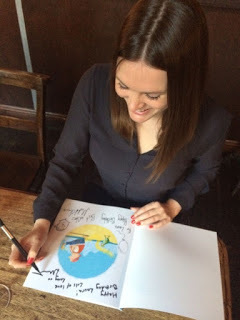 This year was also the first time that I was asked to speak to adults about my writing. I was asked by Fiona Barker who, along with Kate Poels, hosts ‘Picture Book Club’ in Reading and Windsor. Pitched as a ‘monthly book club for grown-ups who love picture books’, Fiona says that Picture Book Club is for authors, illustrators, anyone with ambitions of writing picture books, lovers of art and illustration and for those who want to learn just a little bit more about children’s publishing.
This year was also the first time that I was asked to speak to adults about my writing. I was asked by Fiona Barker who, along with Kate Poels, hosts ‘Picture Book Club’ in Reading and Windsor. Pitched as a ‘monthly book club for grown-ups who love picture books’, Fiona says that Picture Book Club is for authors, illustrators, anyone with ambitions of writing picture books, lovers of art and illustration and for those who want to learn just a little bit more about children’s publishing. I met Fiona at the SCBWI_BI conference in November last year. When she first asked me to speak at Picture Book Club, I was a little nervous as I haven’t studied Children’s Literature or taken any formal writing classes. Fiona, however, invited me to come along and see Picture Book Club in action.
Fortunately I took her up on her offer and went to watch Mat Tobin whose talk was fascinating, interactive and really eye-opening. Unfortunately, Mat Tobin also happens to be a senior lecturer in English and Children’s Literature at Oxford Brookes and he really knows his stuff…so this experience did little to calm my nerves! However, Fiona reassured me once again and she suggested that I speak about my journey to publication …so that’s what I did.
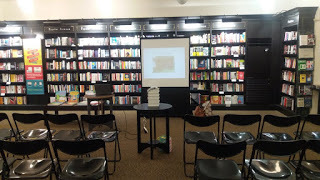 Getting ready in Waterstones, Reading.
Getting ready in Waterstones, Reading.Speaking at Picture Book Club was a GREAT experience and, with a lovely supportive audience of picture book-enthusiasts, what could really go wrong? There was plenty of time for chats, drinks and book-browsing in the Waterstones Children’s section and of course, no Picture Book Club is complete without one of Fiona’s famous (and often book-themed!) cakes. Check out some of her creations so far!
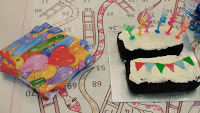
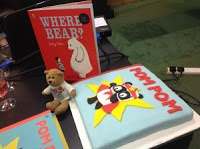
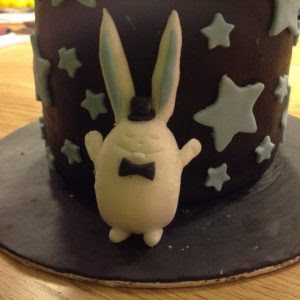
Fiona and Kate have managed to secure some fantastic speakers, from Author/Illustrators Sophy Henn and Meg McLaren to Literary Agents James and Lucy Catchpole (to name but a few). The evenings are very relaxed and informal and every so often Picture Book Club even goes on tour! This year it has been to Oxford and I’m told that a Summer trip to Exeter is also planned. You can find out what’s coming up at Picture Book Club here http://fionabarker.co.uk/picture-book-club/
For those living further South, fear not! A new branch of Picture Book Club has recently been set up by Melanie McGilloway, Emma Perry and Greet Pauwelijn and it has had some wonderful speakers so far- Yasmeen Ismail (hugely talented Author/Illustrator) and Author, Michelle Robinson (who needs no introduction to Picture Book Den readers!) You can find out more information about Picture Book Club’s South West chapter by following the hashtag #picturebookclubSW on twitter.
This year of firsts, including my first 'Picture Book Club', has taught me to be brave and to say ‘Yes’. Author, Tracey Corderoy, speaking at a Nosy Crow Picture Book Master Class, once explained that she says ‘Yes’ to everything and then works out how she’s going to do it later. I think that sounds like a pretty good rule.
I shall definitely be going back to Picture Book Club, for more book chats and more cake! And who knows, perhaps I’ll be invited back to talk again one day? Though my next picture book, with illustrator Mark Chambers , is called ‘Jake bakes a Monster Cake’ and I’m not sure anyone will want a cake quite like this one! Fiona, are you up for a new baking challenge?!
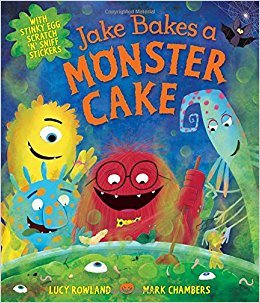
‘Jake Bakes a Monster Cake’ written by Lucy Rowland and illustrated by Mark Chambers is out in September 2017 and is published by Macmillan.
Published on July 30, 2017 23:00
July 23, 2017
Now For Something A Little Different • Lynne Garner
I was recently asked to visit a school as part of their 'aspirations day' and talk about being an author. As I have close ties with the school I agreed. The day came and I was led to the second year room and sat in front of 20 or so year two children. After introducing myself and telling them about my typical writing day I asked if there were any questions. The first question I was asked was where do you get your ideas from? My response was anywhere and everywhere. Including:
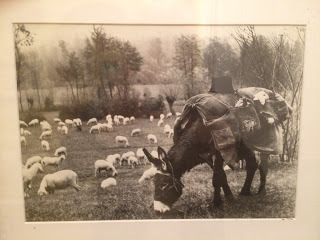 Seeing random objects whilst I'm out walkingSitting in a pub or similar, especially when I overhear an interesting conversation On the train, again overheard conversations are wonderful generators of ideas In the car as a passenger when I'm watching the world go byReading snippets in a newspaper, when I should be cleaning out hutchesMy last example received a giggle or two. I admitted my last flash of inspiration was whilst sitting on the loo of a very quaint tea room. Among the many photographs was this one of a donkey, wearing a fab utility coat full of pockets and interesting items. I have a few ideas floating around but nothing concrete, yet.
Seeing random objects whilst I'm out walkingSitting in a pub or similar, especially when I overhear an interesting conversation On the train, again overheard conversations are wonderful generators of ideas In the car as a passenger when I'm watching the world go byReading snippets in a newspaper, when I should be cleaning out hutchesMy last example received a giggle or two. I admitted my last flash of inspiration was whilst sitting on the loo of a very quaint tea room. Among the many photographs was this one of a donkey, wearing a fab utility coat full of pockets and interesting items. I have a few ideas floating around but nothing concrete, yet.
I was then asked how random objects could generate a story. I replied things can spark different ideas based on our life experiences and our imagination. So here is the 'now for something a little different' part of this post.
Below I've inserted a few random objects I've photographed whilst out walking. I'm inviting you to give one of these objects a story, a life of it's own. Go on give it a go. I'd love to read what life you think these objects had prior to being lost or discarded in the grass.

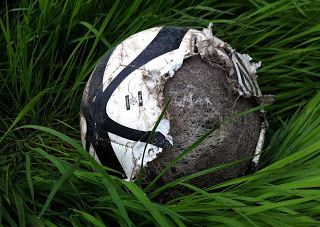
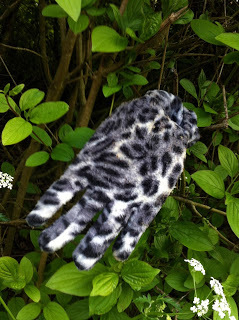
If you've taken the time to write a few words thank you. I hope you enjoyed the process and fingers crossed it may even give you an idea for your next piece of writing.
Regards
Lynne
Now for a blatant plug:
NEW RELEASEHedgehog of Moon Meadow FarmUK - ebook and paperbackUS - ebook and paperback
SALE - bit.ly/BrerRabbitTales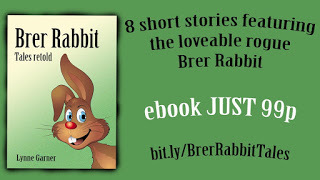
 Seeing random objects whilst I'm out walkingSitting in a pub or similar, especially when I overhear an interesting conversation On the train, again overheard conversations are wonderful generators of ideas In the car as a passenger when I'm watching the world go byReading snippets in a newspaper, when I should be cleaning out hutchesMy last example received a giggle or two. I admitted my last flash of inspiration was whilst sitting on the loo of a very quaint tea room. Among the many photographs was this one of a donkey, wearing a fab utility coat full of pockets and interesting items. I have a few ideas floating around but nothing concrete, yet.
Seeing random objects whilst I'm out walkingSitting in a pub or similar, especially when I overhear an interesting conversation On the train, again overheard conversations are wonderful generators of ideas In the car as a passenger when I'm watching the world go byReading snippets in a newspaper, when I should be cleaning out hutchesMy last example received a giggle or two. I admitted my last flash of inspiration was whilst sitting on the loo of a very quaint tea room. Among the many photographs was this one of a donkey, wearing a fab utility coat full of pockets and interesting items. I have a few ideas floating around but nothing concrete, yet. I was then asked how random objects could generate a story. I replied things can spark different ideas based on our life experiences and our imagination. So here is the 'now for something a little different' part of this post.
Below I've inserted a few random objects I've photographed whilst out walking. I'm inviting you to give one of these objects a story, a life of it's own. Go on give it a go. I'd love to read what life you think these objects had prior to being lost or discarded in the grass.



If you've taken the time to write a few words thank you. I hope you enjoyed the process and fingers crossed it may even give you an idea for your next piece of writing.
Regards
Lynne
Now for a blatant plug:
NEW RELEASEHedgehog of Moon Meadow FarmUK - ebook and paperbackUS - ebook and paperback
SALE - bit.ly/BrerRabbitTales

Published on July 23, 2017 22:30
July 16, 2017
Can you teach people how to write a good picture book? • Pippa Goodhart
No and yes.
No, in that there are no clear rules that can be learnt and followed that would fit all good picture books. If you set rules for picture book writing they might include …
Rule 1) Remember that pictures are the key feature of any picture book. That’s why they are called picture books. But then you’d never get a brilliant and successful book such as this –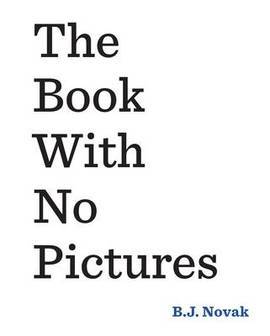 Rule 2) When writing for young children you must always supply a happy ending. But then you’d never get an important honest books such as this –
Rule 2) When writing for young children you must always supply a happy ending. But then you’d never get an important honest books such as this –
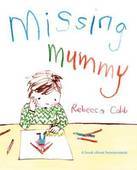
Rule 3) When writing for such a young audience, you must make clear exactly what is happening in the story. And then we’d miss out on genius such as this –

So, no, you can’t neatly teach picture book writing in that didactic sort of way. But you certainly can equip people with necessary knowledge for writing picture books, and also nurture their skills at working with pictures and the book format to convey stories suited to both target audience and market place. I’ve just finished teaching another run of the four week online course in picture book writing that I do via the Writers’ Workshop. On that course, I take students back to thinking about what life was like when they were of the 2-5 year old core picture book audience age themselves. What mattered to them? What did they find funny? I tell them a bit about the often international market for picture books. We think about what a story is, and how best to play it between words and pictures and page turns. We think about writing style, how the text must read out loud pleasingly, the potential pitfalls of writing in rhyme, how dialogue can bring pictures to life, and so on. I asked the participants on the recent course what they thought about that course, and perhaps the most telling comment was this –‘I learned a lot through doing (making mistakes, your comments, having another shot at it).’It’s that having a go, actually doing, and then discussing the results, that develop writing skills far more than teaching 'rules' ever could. It’s what I get from group of writing friends I belong to where we meet regularly, bounce ideas around, read out work and critique it, but the course provides that supportive yet critical community virtually. I love it.Still no guarantee that it will result in a publishing contract and book sales, though!
Do any of you have experiences of courses in picture book writing? Can you think of any other books that clearly disobey the sorts of rules that might be thought to apply to the writing of picture books?
No, in that there are no clear rules that can be learnt and followed that would fit all good picture books. If you set rules for picture book writing they might include …
Rule 1) Remember that pictures are the key feature of any picture book. That’s why they are called picture books. But then you’d never get a brilliant and successful book such as this –
 Rule 2) When writing for young children you must always supply a happy ending. But then you’d never get an important honest books such as this –
Rule 2) When writing for young children you must always supply a happy ending. But then you’d never get an important honest books such as this –

Rule 3) When writing for such a young audience, you must make clear exactly what is happening in the story. And then we’d miss out on genius such as this –

So, no, you can’t neatly teach picture book writing in that didactic sort of way. But you certainly can equip people with necessary knowledge for writing picture books, and also nurture their skills at working with pictures and the book format to convey stories suited to both target audience and market place. I’ve just finished teaching another run of the four week online course in picture book writing that I do via the Writers’ Workshop. On that course, I take students back to thinking about what life was like when they were of the 2-5 year old core picture book audience age themselves. What mattered to them? What did they find funny? I tell them a bit about the often international market for picture books. We think about what a story is, and how best to play it between words and pictures and page turns. We think about writing style, how the text must read out loud pleasingly, the potential pitfalls of writing in rhyme, how dialogue can bring pictures to life, and so on. I asked the participants on the recent course what they thought about that course, and perhaps the most telling comment was this –‘I learned a lot through doing (making mistakes, your comments, having another shot at it).’It’s that having a go, actually doing, and then discussing the results, that develop writing skills far more than teaching 'rules' ever could. It’s what I get from group of writing friends I belong to where we meet regularly, bounce ideas around, read out work and critique it, but the course provides that supportive yet critical community virtually. I love it.Still no guarantee that it will result in a publishing contract and book sales, though!
Do any of you have experiences of courses in picture book writing? Can you think of any other books that clearly disobey the sorts of rules that might be thought to apply to the writing of picture books?
Published on July 16, 2017 16:30



